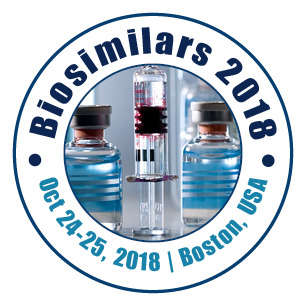
Candida Fratazzi
Bull Breed Coalition Registry Consulting,USA
Title: E-BABE: How to address immunogenicity in the development of a rare disease biosimilar
Biography
Biography: Candida Fratazzi
Abstract
Rare diseases hugely need moderate treatment choices. Vagrant medications have been ignored by the biosimilar business for quite a while. Patient’s advocates that people with rare diseases have access to safe and effective biologic and biosimilar medicines. Worldwide, 350M people are estimated to suffer from a rare disease, including 25-30M US and 30M EU residents. With >60% biologics represent most of the worldwide vagrant medication advertise. A noteworthy issue with protein-based therapeutics is their immunogenicity.Forms of an immune response are the activation of B cells, and T-cells, which help to activate B cells. The T-cells react in a typical response to a fake protein remedial as though it were outside since it is unique in relation to the imperfect, common protein. A T-cell reaction confound like this occasionally happens on account of the protein FVIII. Virtually all therapeutic proteins (biologics) evoke an insusceptible reaction with the resulting creation of hostile to medicate antibodies (ADA). The ADA to therapeutic monoclonal antibodies (mAbs) that are coordinated against the antigen-binding site of the therapeutic mAb is neutralizing. This nature of the ADA reaction explains why fully human antibodies can still be exceedingly immunogenic. Biosimilars have to be tested for their immunogenicity as it is impossible to predict if they will induce an immunogenicity similar to the one manifested by the corresponding innovator biologics. Infusion-related reactions (IRRs) include hypersensitivity reactions and cytokine release syndromes. Hypersensitivity reactions have classically been partitioned into type I, II, III, and IV reactions; type I and III reactions are those regularly observed following administration of biologics. The infusion-related reaction is defined as a disorder characterized by an adverse reaction to the infusion of pharmacological or biological substances and as a disorder characterized by nausea, headache, tachycardia, hypotension, rash, and shortness of breath and caused by the release of cytokines. Infusion-related reactions are common and timely related to drug administration and have been reported as anaphylaxis, anaphylactoid reactions, and cytokine release syndrome, among other terms used. Animal toxicology studies are neither predictive of severe IRRs nor of hypersensitivity in human. With respect to intravenous (IV) administration, the SC route offers more convenience to patients, flexibility in dosing, and potential to lessen medicinal services costs. There is a perception that SC organization can represent a higher immunogenicity hazard than IV administration for a given protein.However, a recent comparative clinical study of sc vs iv administration of abatacept showed that the efficacy and immunogenicity are comparable between the two routes of administration.

